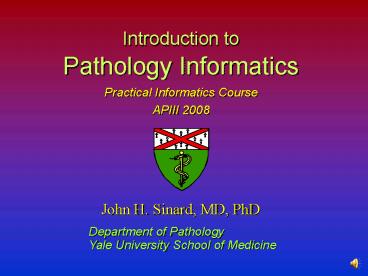Introduction to Pathology Informatics PowerPoint PPT Presentation
1 / 19
Title: Introduction to Pathology Informatics
1
Introduction to Pathology Informatics
- Practical Informatics Course
- APIII 2008
2
What is Pathology Informatics?
- The term has been defined largely by its usage,
and its meaning is evolving (expanding) - For many, informatics the use of computers (or
any and all technology) in the practice of a
discipline - Shifts focus to the tools themselves rather than
how the tools are used - e.g., laboratory medicine is not simply the use
of instruments to analyze blood - e.g., molecular biology is not the use of
bacteria in biology - Dilutes the intent of defining an academic
discipline
3
Informatics vs Computer Science ?
- Computer Science, among many other things,
addresses how data is stored and organized in a
computer. - For the most part, however, computer scientists
focus on the storage of the data itself, often
without consideration for what the data
represents in terms of real-life concepts - Knowledge of the real-life concepts represented
by the data, including the inherent and implicit
relationships these concepts impose, is critical
to proper management of that information. This
domain layer is an important part of what
separates informatics from computer science
4
141
1
8
5
73
21
13
56
92
5
(No Transcript)
6
Y
C
H
I
P
V
F
S
K
W
N
7
(No Transcript)
8
A - Alanine C - Cysteine D - Aspartic Acid E -
Glutamic Acid F - Phenylalanine G - Glycine H -
Histidine I - Isoleucine K - Lysine L -
Leucine M - Methionine N - Asparagine P -
Proline Q - Glutamine R - Arginine S - Serine T
- Threonine V - Valine W - Tryptophan Y - Tyrosine
Y
C
P
H
N
S
I
C
P
V
I
V
F
K
S
Y
H
F
W
K
W
N
9
H
Y
C
C
N
F
P
S
H
I
V
K
P
I
Y
V
W
F
S
K
W
N
10
Informatics
- The study and practice of data acquisition,
storage, processing, retrieval, analysis, and
presentation to facilitate workflow and increase
the accuracy and value of the information
contained within the data - Computer not part of the definition discipline
could have existed a century ago - Information explosion, plus demands to make
greater use of that information - Manual management becomes inefficient and
impractical - Computer becomes an indispensable tool for the
discipline of informatics - Knowledge of the real-life concepts represented
by the data, including the inherent and implicit
relationships these concepts impose, is critical
to proper management of that information. This
domain layer is an important part of what
separates informatics from computer science
11
Informatics is a Process
- Productivity Tools
- Knowledge Management Tools
- Decision Support Tools
12
Overlapping Scope of Informatics
13
The Role of the Pathologist in Patient Care
- Pathologists do not simply attach names to pieces
of tissue or report numbers measured by a
machine we provide an assessment which directs
the clinical care of the patient - The final interpretation is based not solely
upon the tissue and/or the results of analysis,
but rather is tempered by the clinical setting - We choose the wording of our interpretive reports
to trigger the appropriate clinical response - Tools
- The histologic image is one of the richest data
streams in medicine, and the ability of the
pathologist to synthesize and interpret this
information is unlikely to be duplicated
electronically for some time - Other techniques immunohistochemistry, flow
cytometry, gene rearrangement studies, molecular
tests
14
PathologyToday
Electronic Data Layer
- Information systems used predominantly to manage
practices and workflow - Limited use to access external data sources
- No direct feedback from patient outcome
Dx
Rx
15
Controlling the Flow of Information
- Vast amounts of data need to be assimilated,
filtered, and presented in such a way as to
convert it into usable information - Informatics tools will be needed to assist in the
data integration process - The decision making role in medicine will go to
whoever can most effectively mobilize,
capitalize, and leverage the informatics
resources necessary to make this a reality - Two views of the future
16
Pathologist as Data Provider
Electronic Data Layer
- Pathologist limits evaluation to tissue or fluids
submitted - Pathology output is a data element in treating
clinicians decision support system - As treating clinicians draw on other data
sources, relative contribution of pathologist
decreases
Electronic Data Layer
Decision Support
Dx Rx
17
Pathologist as Diagnostic Specialist
Electronic Data Layer
- Pathology moves aggressively to develop and adopt
informatics tools to leverage data from emerging
technologies - Pathologist remains a diagnostic consultant,
providing outcomes based treatment
recommendations to treating clinicians
Decision Support
Dx
Rx
18
Choosing our Future
- Pathologist as a Data Provider
- Easier steady-as-she-goes result
- Pathology is protected from the new diagnostic
modalities - As new diagnostic modalities proliferate, the
relative contribution of the pathology decreases - Pathologist as the Diagnostic Specialist
- Pathologists, largely freed from details of
day-to-day patient management, are better
positioned for data integration - More in keeping with the current roles and
interests/personalities of the respective
players, - Pathologists and pathology departments must move
aggressively to develop the skills and the
informatics infrastructure necessary to leverage
the information explosion
19
Practical Informatics Course
- Introduction to Pathology Informatics (Sinard)
- Databases and Data Storage (Sinard)
- Data, Messaging Standards, and Interfaces
(Gilbertson) - Break
- Digital Imaging Basics (Sinard)
- Telepathology and Whole Slide Imaging (Parwani)
- Introduction to Bioinformatics (Chandran)

